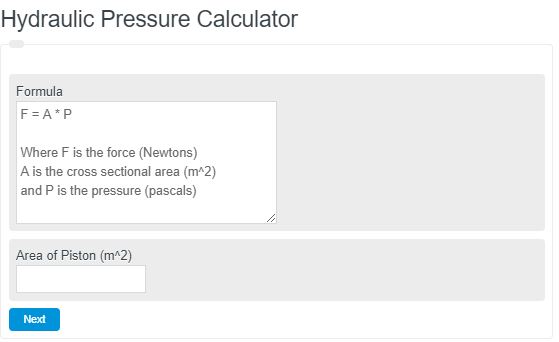Enter the liquid pressure and the cross-sectional area of a hydraulic cylinder to calculator the force acting on that cylinder due to the liquid pressure.
- Hydrostatic Pressure Calculator
- Partial Pressure Calculator
- Vapor Pressure Calculator
- Hydraulic Radius Calculator (+ Wetted Perimeter)
- Hydraulic Force Calculator
- Hydraulic Motor Flow Calculator
- Hydraulic Fluid Velocity Calculator
- Hydraulic Line Loss Calculator
Hydraulic Pressure Formula
The following formula is used to calculate the force acting on a hydraulic piston that is being subjected to pressure.
F = A * HP
- Where F is the force (Newtons)
- A is the cross-sectional area (m^2)
- and HP is the pressure (pascals)
This formula is derived from the laws of fluid dynamics. This can be further explored in Pascal’s principle which states that if pressure is applied to a container of liquid that pressure is transmitted everywhere in that container.
Hydraulic Pressure Definition
Hydraulic pressure is defined as the force acting on a hydraulic piston due to pressure and a certain cross-sectional area of the piston.
How to calculate hydraulic pressure?
How to calculate hydraulic pressure.
- First, determine the cross sectional area.
Measure the cross-sectional area of the piston.
- Next, determine the force of the piston.
Measure the force produced by the piston.
- Finally, calculate the hydraulic pressure.
Using the formula above, calculate the hydraulic pressure which would be P = F/A.
FAQ
Hydraulic pressure is known as the total pressure acting on a cross-sectional area of a hydraulic piston that produces a force.
